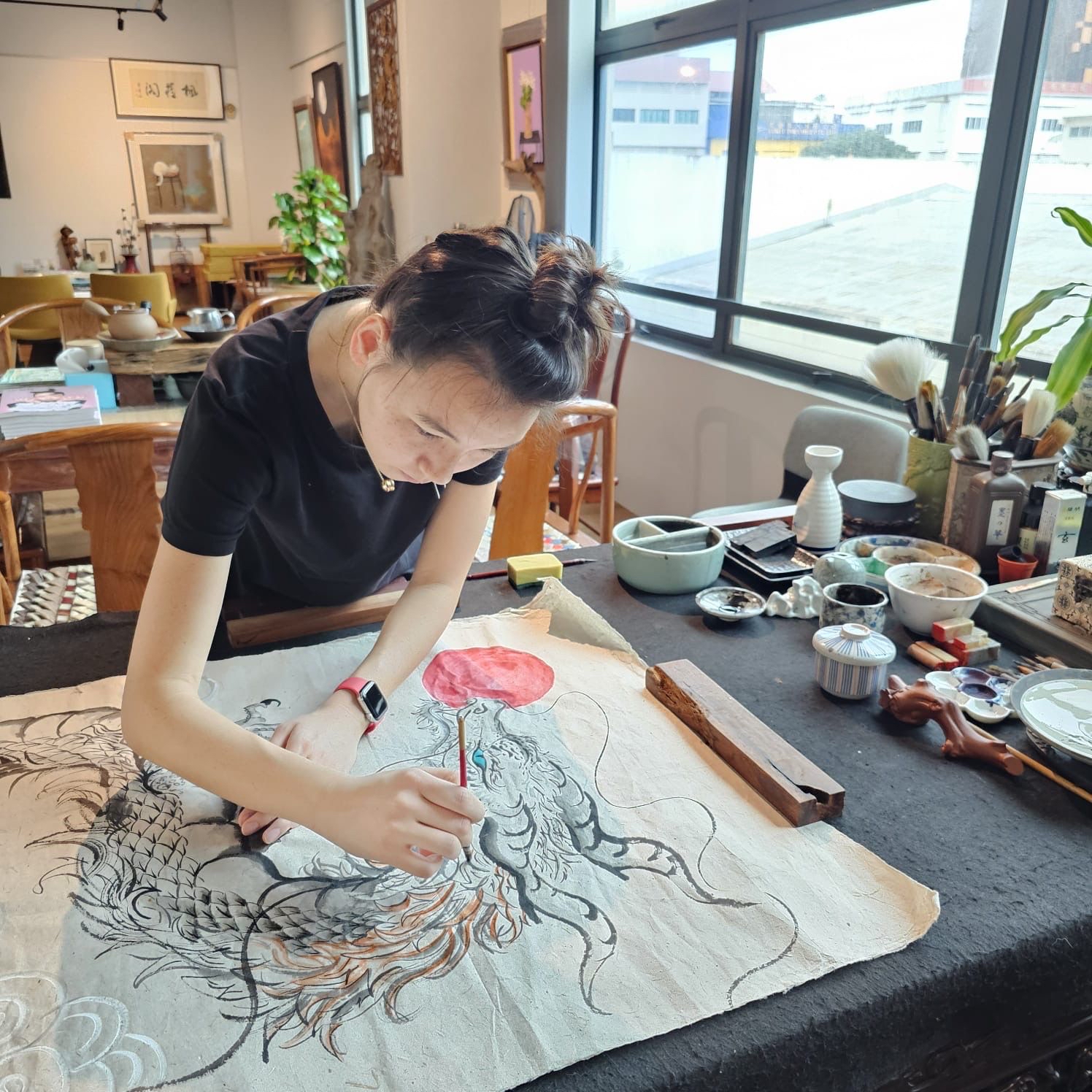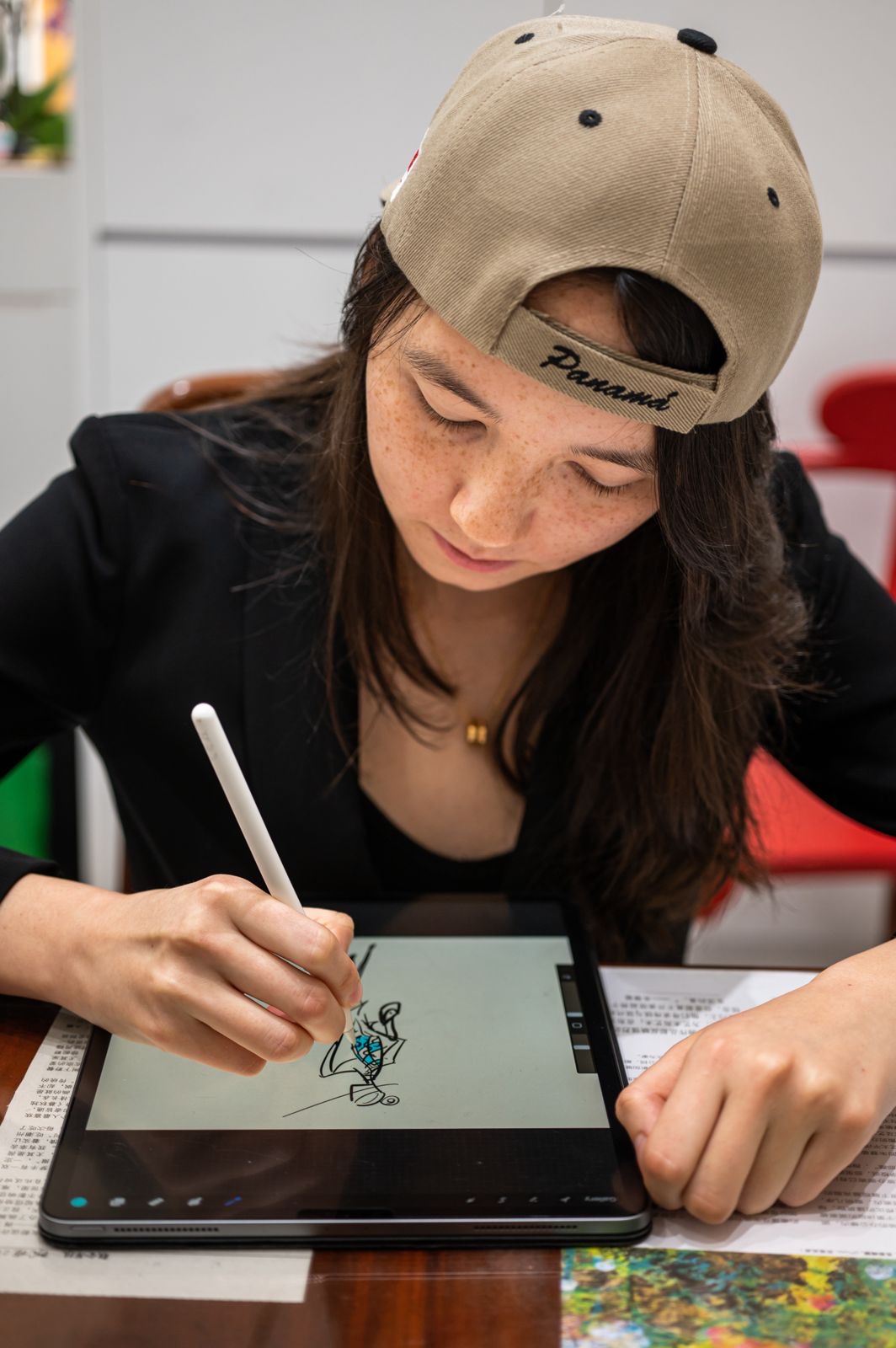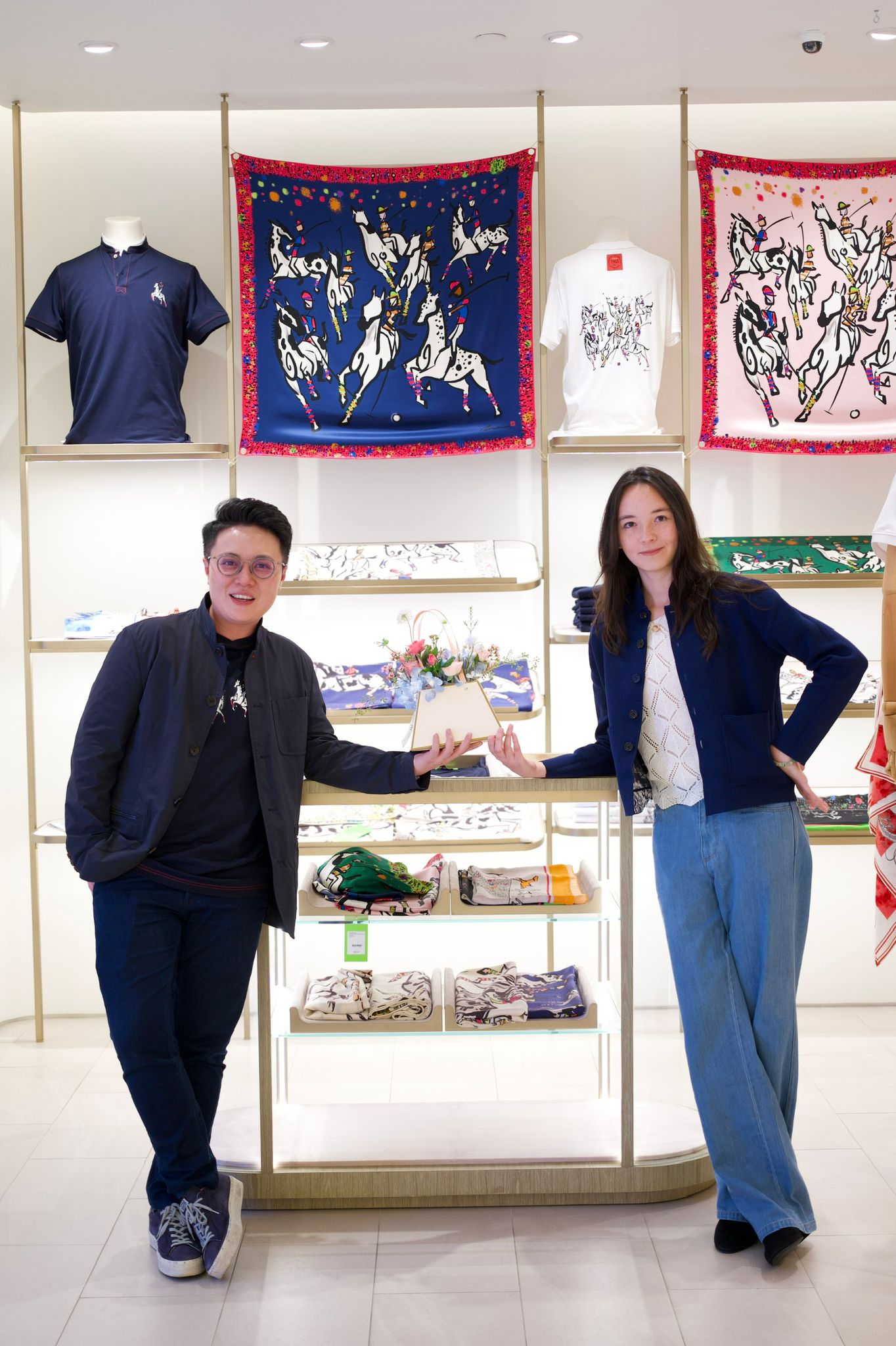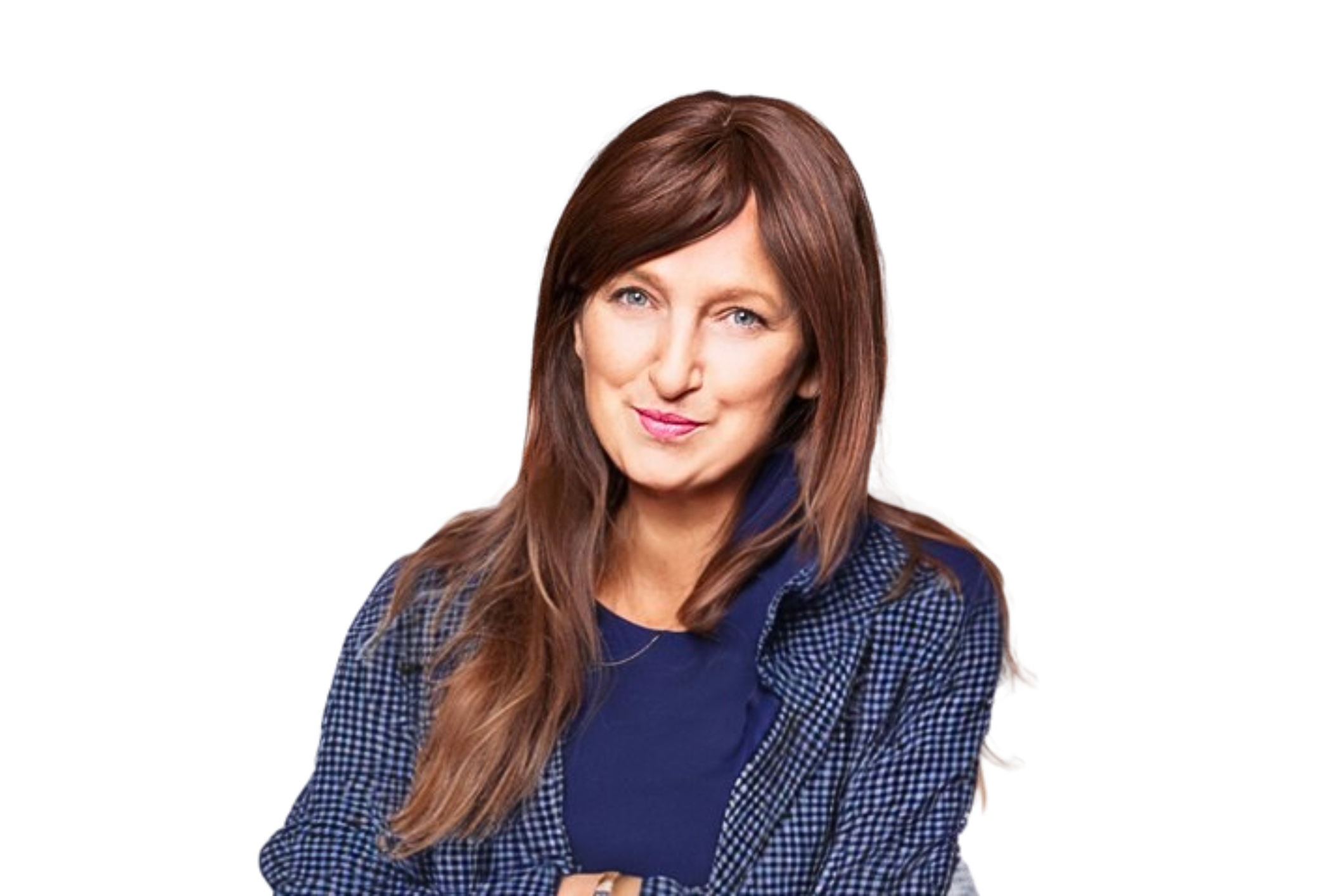The Rising Voice of a New-Gen Artist Blending Chinese and Modern Painting
In an increasingly interconnected world, the boundaries between cultural expression and artistic identity are becoming ever more fluid. Nawei, a bold young Canadian artist based in Singapore, is among the emerging generation of artists who masterfully blend the heritage of Chinese ink traditions with the color, energy, and imagination of modern art. With work that pulses with symbolism, movement, and soul, she’s carving a space that both honors the past and dares to redefine it.
“I’ve been painting for as long as I can remember,” she reflects. “If there was a pen and a scrap of paper, I’d find myself sketching whatever came to mind or whatever I saw around me.” What started as innocent doodles soon became something deeper, as the people around her began noticing the quality of her work. The attention she received made her realise that art wasn’t just something she loved, but that it was her true calling.

(Photo: Nawei)
The Early Imprint of Ink and Identity
Although Chinese painting wasn’t the only influence in her early years, it left a deep and lasting impression. “I was surrounded by many different forms, and Chinese painting was one of them,” she explains. “There’s something deeply moving about the contrast between bold, expressive strokes and the delicate elegance of ink on rice paper.” That unique balance between energy and restraint, between form and formlessness, fascinated her.
Her godmother, an early mentor, first introduced her to acrylic techniques. This exposure opened a door that would eventually lead her to the Nanyang Academy of Fine Arts (NAFA)’s junior art programme, where she honed foundational skills. But formal education was only one piece of the puzzle. Much of her growth came from self-study, poring over books on art history, experimenting with brush and ink, and joining workshops with fellow artists. This hybrid of formal and informal learning gave her the freedom to explore without boundaries.
Her influences, she says, are not limited to artists. “History, philosophy, and the wildlife around me constantly inspire me. The details that fascinate me, those often find their way into my work.”

(Photo: Nawei)
Finding Her Voice in Fusion
When asked how she would describe her current artistic style, she smiles. “Bold and detailed, yet elegant. I like to think it carries a distinct soul and a sense of movement that draws the viewer in.”
That sense of movement is not only visual, it’s cultural. Being of mixed heritage and raised in Asia, she considers her fusion of Chinese and modern styles a natural evolution of her identity. “It reflects who I am. It gives me a broader range of possibilities and tools to bring my ideas to life.”
Her paintings often begin with traditional Chinese techniques, brushwork inspired by calligraphy, ink wash layers that build depth and atmosphere. But she’s not afraid to challenge tradition. Dragons and tigers, a nod to Chinese mythology might appear in vibrant Western palettes, drawn in compositions that defy classical conventions. “These creatures don’t just look powerful, they carry layers of cultural meaning. They allow me to weave a sense of quiet movement and memory into my work.”
Layered onto this are modern elements: Western themes, bold colors, and techniques like glazing and digital sketching. “The contrast between subtle ink tones and vibrant modern colors creates a kind of dialogue between two worlds,” she says. But she insists that this merging of styles was never an intentional manifesto, it simply unfolded over time. “Because I’m mostly self-taught and exposed to so many different kinds of art, the blending happened naturally. It’s how I express myself.”
Themes That Echo Through Time
Her recurring themes reveal a fascination with history and myth. “Animals, mythology, and historical subjects keep drawing me back. There’s a mystery and timelessness in them that I find deeply inspiring.”
The influence of Chinese philosophy subtly weaves itself through her compositions. Concepts like yin and yang, or the notion of qi, the invisible energy that flows through everything are mirrored in her approach to composition and balance. “Even if the viewer doesn’t consciously notice it, I think they feel it,” she says. Tigers and dragons, for example, are more than just visual motifs, they represent power, spirit, and the duality of nature.
Yet, unlike some artists who turn their canvas into social commentary, her work steers away from directly addressing current events. “I aim to create art that sparks imagination, curiosity, happiness, and a sense of meaning. If someone leaves feeling inspired or uplifted, that means everything to me.”
From Thought to Brushstroke
The creative process begins in the imagination. “I usually start with a subject in mind – say, a tiger. I imagine its movements as if it were alive right in front of me. Is it hunting? Resting? About to leap?” From that visualisation, the painting begins to take form. Layer by layer, the setting and emotional tone are built whether it’s nightfall, dense foliage, or the shelter of a tree, each detail adding dimension to the narrative.
Despite her fluency with digital tools today, she began traditionally, with pencils, pens, ink, and acrylics. “Digital tools came much later for me. I use them more as a way to visualise and refine, especially for large projects. But for soul work? I still prefer my brushes.”
Her favourite mediums remain Chinese paper and linen. “Chinese paper is unforgiving, you can only add, not take away. It forces you to trust your intuition. Linen, on the other hand, gives me more room to experiment. I enjoy what both offer.”
Reception, Challenges, and Cultural Responsibility
With such a unique blend of influences, responses to her art are varied and sometimes surprising. “No matter the age or background of my audience, they always bring their own interpretations. That’s what I love. I see my painting one way, but they may see something entirely different.”
Yet not all feedback is easy. “Some people struggle with the idea of Western subjects painted using Eastern mediums. I get that because it challenges their expectations.” But she sees this friction as necessary. “Art is about crossing boundaries. Traditions and tools aren’t limits, they’re part of the story.”
Her hope is simple: “I want people to feel intrigue and wonder. I want the painting to live on in their minds and emotions. If it inspires, connects, or gives them peace, I’ve done my job.”
With that, she also acknowledges a deeper responsibility to honour Chinese artistic heritage, while pushing it forward. “Every form of art deserves respect. By reinterpreting it through my lens, I hope to keep the traditions alive for the future.”
The Road Ahead
One of her proudest moments was her first solo show last December, centred on the theme of polo players. “It was about sportsmanship, determination, and excitement. But more than that, it was a way of announcing to the world that making art is my life’s pursuit.”
With growing recognition has come the challenge of managing the business side of art galleries, collectors, and social media. “I’m still learning every day. Thankfully, I have the team at Gallery NaWei to support me, so I can stay focused on the art.”
Her future is already taking shape. A collaboration with iconic fashion house Shanghai Tang launches in Aug 2025, blending art with luxury design. Known for fusing Chinese heritage with modern luxury, the brand saw in her work a perfect complement to their vision. The collaboration features exclusive designs that seamlessly integrate her expressive brushwork with the brand’s high-end fashion pieces. “Nawei’s debut for Shanghai Tang captures the strength and rhythm shared between rider and steed in patterns reflective of Chinese ink and Western acrylics with vibrant accents along the edge.” shared Octo Cheung, Vice President of Shanghai Tang.

(Photo: Nawei)
She’s also preparing for another show in Singapore, where she plans to push boundaries further, perhaps reimagining what ink on rice paper can be, and introducing canvas works in her distinct style. “My goal is always to grow, to create something new and exciting.”
In five to ten years, she envisions herself expanding into new mediums, building a deeper foundation, and sharing her philosophy more widely, perhaps even mentoring or collaborating across cultural borders. “I want to continue painting but also be in conversation with other artists and communities. That exchange is vital.”
A Cultural Dialogue in Every Stroke
She believes that her generation is redefining Chinese art, not by abandoning tradition, but by expanding it. “With so much cultural exchange happening now, these influences flow more freely than ever. It opens up fresh approaches and new possibilities.”
For her, each piece is a conversation, a form of cultural dialogue. “I hope my art becomes a point of connection. When someone hangs a piece in their home, I hope it sparks curiosity, discussion, and maybe even brings people a little closer.”
Her advice to other young artists exploring cultural fusion? “Do your research. Immerse yourself in the culture. Take time to understand the nuances. And most of all enjoy the process. Let it be an adventure.”
In her work, tradition doesn’t stay frozen in time it breathes, moves, and evolves. And in doing so, she’s not just painting. She’s writing a new chapter for Chinese art, one vibrant stroke at a time.
Stay ahead with exclusive insights! Sign up for our mailing list and never miss an article. Be the first to discover inspiring stories, valuable insights and expert tips – straight to your inbox!




